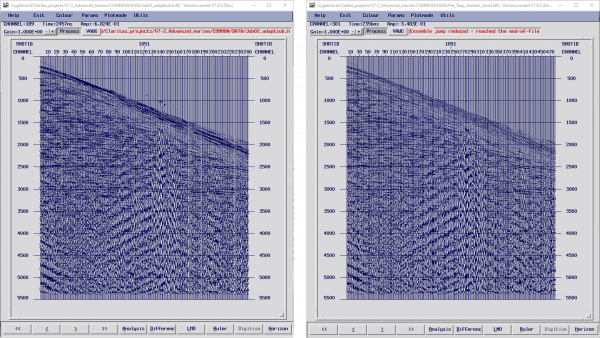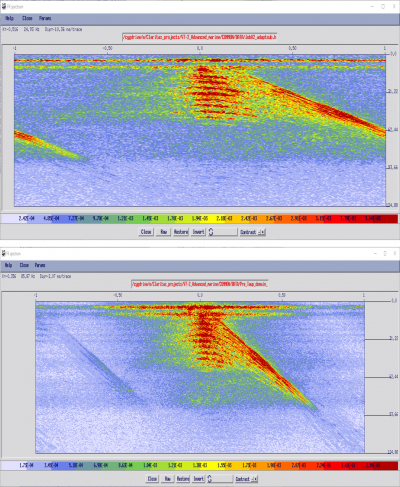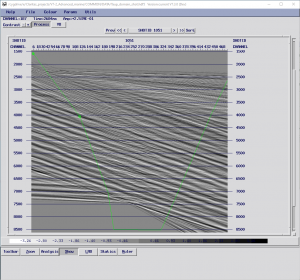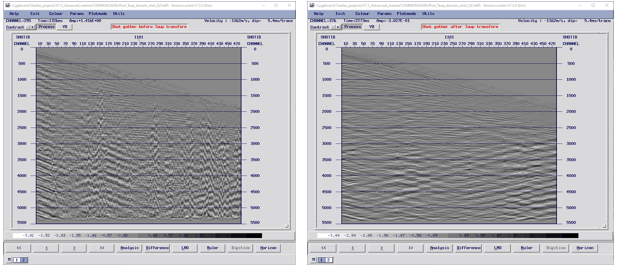
How can I get the best results from my Tau-P transformation in GLOBEClaritas?
Tau-P domain processing can be a very powerful option for removing linear noise or attenuating short period reverberant multiples. As such, it is important to optimize the pre-processing and the actual Tau-P transform itself in order to make sure you achieve the best results possible from Tau-P domain processing.
Pre-conditioning Prior to Transformation
It’s always valuable to review your input data to find out if it would benefit from any pre-conditioning prior to transformation into the Tau-P domain. This will encompass basic steps such as trace editing/deswell etc to remove noise bursts or spikes that might cause issues when transformed in and out of Tau-P domain such as transform impulse responses etc. As a safety net, you can apply a wraparound AGC to control amplitudes in and out of the transform.
Consider how well the data has been sampled spatially
Is there any evidence of spatial aliasing in the gathers when viewed in SV or SeisView? If so, consider some level of spatial resampling or interpolation (see find link to article), however at some level applying spatial up sampling is beneficial to the Tau-P transform.
The better the data is sampled in the XT domain the more reliable the Tau-P transform will be.
Below is a single shot gather as acquired prior to spatial resampling and again after spatial resample:-


As you can see from these displays whilst the level of aliasing in the pre interpolated gathers is relatively minor, the aliasing is more apparent when the shot is displayed in the FK domain. Unwrapping the aliasing will be beneficial to the Tau-P transform.
You have prepared the data – now what?
Having prepared the data for input to the Tau-P transform we can now consider how best to parameterize the transform process to optimize the data in Tau-P space.
Key parameters to consider in the Tau-P transform module are the N_PTRACE, VMIN/MAX. Typically it is best to specify an N_PTRACE of equivalent to the input XT domain fold (in the example used after interpolation it is 480 fold). However, it can be beneficial to define a finer sampling in Tau-P domain, and so could be worth testing an N_PTRACE of 720 or 960 fold for example.
To do this you would;
- Pass a single shot in and out of Tau-P domain using the TAUP/TAUPINV modules.
- Confirm the data is safely transformed without desired primary energy being removed or transform artefacts being generated.
- Finally, consider the effects of increased P sampling on the runtime of the processing flow. You may need to compromise on the best possible transform to achieve a turnaround for the processing stage that fits your project timescale.
The VMIN/VMAX parameters define the limits of the transform expressed as a velocity in meters/seconds, other software may well express transform range as a slowness value defined as microseconds per meter. Typically for Marine data transform range should be a value of +/- the water velocity ie VMIN= -1480 m/s to a VMAX of 1480 m/s (slowness of +/- 800 us/metre).
Shot gather in the Tau-P domain :-

Shot gather pre and post Taup transform:-

One positive effect of the transform itself is that any unwanted signal that sits outside the user defined transform range is attenuated. For the shot displayed above, the low frequent linear noise which exhibits an apparent velocity of around 1150m/s does not pass in and out of the Tau-P space and is therefore removed.
This is illustrated very well by the FK spectra of the shot, before and after, Tau-p showing data outside the defined transform range is attenuated.

Effective Sampling is Key
The key to a good Tau-P transform is effective sampling of the wavefield in XT and Tau-P space which is why interpolation of the XT domain gather and a high number of P traces all help to produce the best transform results.
Any questions or if you need assistance do contact the support team at support@globeclaritas.com.
GLOBEClaritas Enquiries
If you would like to know more or have questions please use the form to get in touch with one of our experts.


